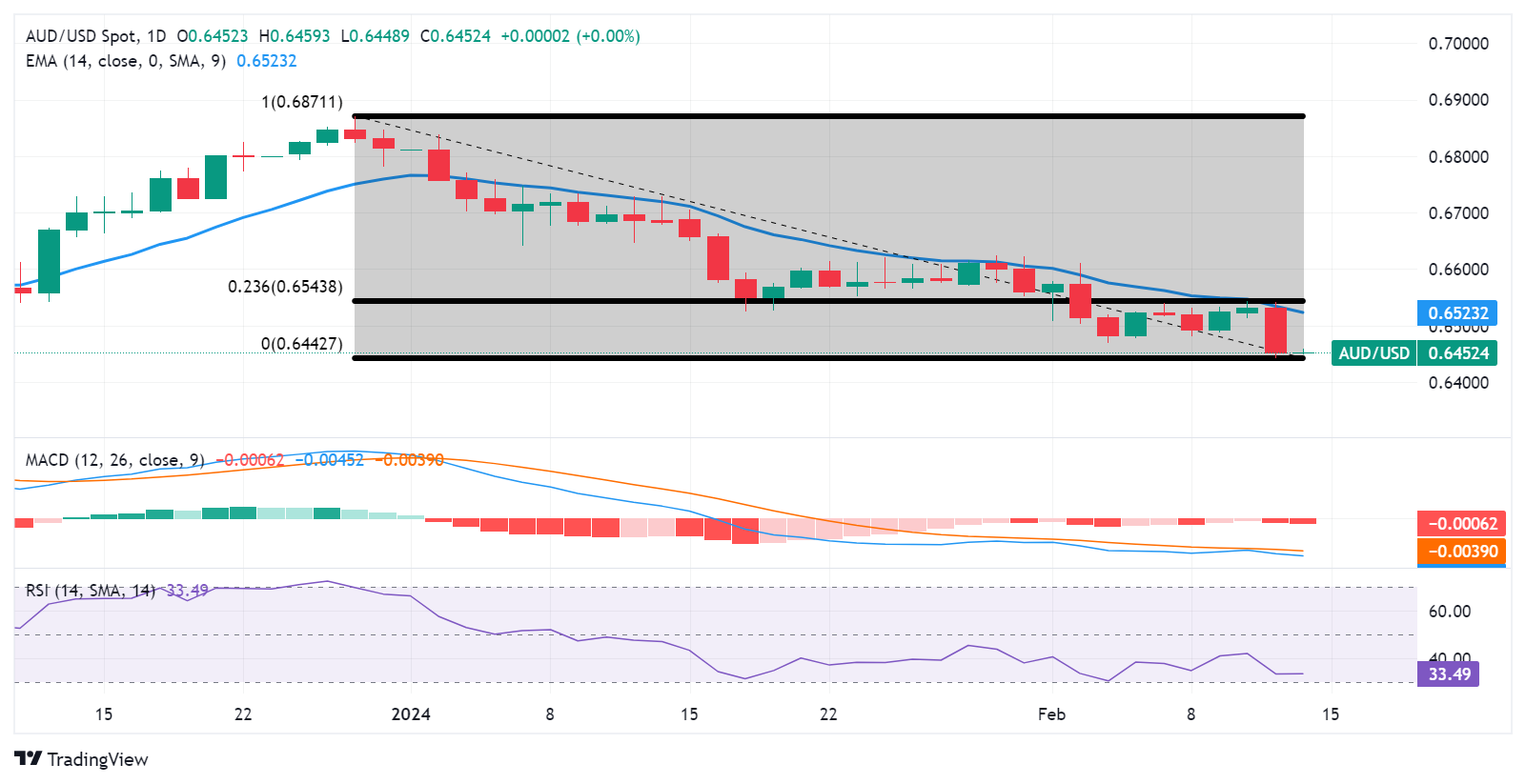- The Australian Dollar lost ground, while the US Dollar rose on the back of encouraging US CPI numbers.
- Australian ASX 200 index falls; pressing the AUD.
- The US dollar strengthened following the rise in US Treasury yields.
- Strong US CPI numbers put paid to chances of a Fed rate cut in March.
The Australian Dollar (AUD) is struggling to recover the losses recorded the previous day. The decline in the AUD/USD pair was fueled by strong US inflation data for January, which dashed hopes of an imminent rate cut by the Federal Reserve (Fed) in March.
The Australian dollar came under downward pressure as the S&P/ASX 200 index fell to its lowest levels in three weeks, driven by a sell-off in mining and financial stocks following Wall Street's plunge the previous day in response to some figures. inflation in the US stronger than expected.
The US Dollar Index DXY is holding steady near three-month highs, supported by recent gains, while US yields are trading at multi-week highs across the yield curve. Market sentiment has changed dramatically, and expectations of the Fed keeping rates unchanged next month have soared to 93%, a stark contrast to the previous month. Investors are now pricing in the possibility that the Fed will cut rates in June.
Daily Market Summary: Australian Dollar Gains Ground on Stable US Dollar
- Stephen Kennedy, head of the Australian Treasury, addressed a parliamentary committee and pointed out that inflation in the services sector lags behind that in goods. He mentioned that services inflation has probably peaked and is expected to decline over the next two years, and he sees no signs of a wage price spiral.
- Reserve Bank of Australia (RBA) Governor Michele Bullock stated that the central bank could consider initiating rate cuts even before inflation slows to 2.5%. However, she warned that the RBA remains receptive to the prospect of further rate hikes.
- The RBA's Director of Economic Analysis, Marion Kohler, highlighted the uncertainty regarding the current inflation forecasts for the Australian economy. However, she expects price growth to return to a more moderate level in 2025.
- China's headline CPI fell 0.8%, beating the forecast decline of 0.5% and the previous 0.3% decline.
- The headline US Consumer Price Index (CPI) rose 3.1% in January, above the 2.9% forecast but below the previous rate of 3.4%.
- US Inflation rose 0.3% month-on-month, compared to the expectation of maintaining the previous reading of 0.2%.
- The US core CPI remained at 3.9% year-on-year, compared to the market forecast for a decline to 3.7% in January.
- US core inflation rose 0.4% monthly versus 0.3% expected.
Technical Analysis: Australian Dollar remains above 0.6450 level
The Australian Dollar traded near 0.6450 on Wednesday, above the next psychological support level at 0.6400. A break below this last level could lead the AUD/USD pair to approach the 0.6350 support level. To the upside, key resistance appears at the psychological level of 0.6500. If it breaks this barrier, the AUD/USD pair could reach the 14-day EMA at 0.6523, followed by the 23.6% Fibonacci retracement at 0.6543 and the 0.6550 level.
AUD/USD Daily Chart

Australian Dollar FAQ
What factors determine the price of the Australian dollar?
One of the most important factors for the Australian Dollar (AUD) is the level of interest rates set by the Reserve Bank of Australia (RBA). As Australia is a resource-rich country, another key factor is the price of its largest export, iron ore. The health of the Chinese economy, its largest trading partner, is a factor, as is inflation in Australia, its growth rate and the Balance of Trade. Market sentiment, that is, whether investors bet on riskier assets (risk-on) or seek safe havens (risk-off), is also a factor, with the risk-on being positive for the AUD.
How do decisions by the Reserve Bank of Australia affect the Australian dollar?
The Reserve Bank of Australia (RBA) influences the Australian Dollar (AUD) by setting the level of interest rates that Australian banks can lend to each other. This influences the level of interest rates in the economy as a whole. The RBA's main objective is to maintain a stable inflation rate of 2%-3% by adjusting interest rates up or down. Relatively high interest rates compared to other major central banks support the AUD, and the opposite for relatively low ones. The RBA can also use quantitative easing and tightening to influence credit conditions, with the former being negative for the AUD and the latter being positive for the AUD.
How does the health of the Chinese economy influence the Australian dollar?
China is Australia's largest trading partner, so the health of the Chinese economy greatly influences the value of the Australian Dollar (AUD). When the Chinese economy is doing well, it buys more raw materials, goods and services from Australia, which increases demand for the AUD and drives up its value. The opposite occurs when the Chinese economy does not grow as fast as expected. Therefore, positive or negative surprises in Chinese growth data usually have a direct impact on the Australian Dollar.
How does the price of iron ore influence the Australian Dollar?
Iron ore is Australia's largest export, with $118 billion a year according to 2021 data, with China being its main destination. The iron ore price, therefore, may be a driver of the Australian dollar. Typically, if the price of iron ore rises, the AUD also rises as aggregate demand for the currency increases. The opposite occurs when the price of iron ore falls. Higher iron ore prices also tend to result in a higher likelihood of a positive trade balance for Australia, which is also positive for the AUD.
How does the trade balance influence the Australian dollar?
The trade balance, which is the difference between what a country earns from its exports and what it pays for its imports, is another factor that can influence the value of the Australian dollar. If Australia produces highly sought-after exports, its currency will gain value solely from the excess demand created by foreign buyers wanting to purchase its exports versus what it spends on purchasing imports. Therefore, a positive net trade balance strengthens the AUD, with the opposite effect if the trade balance is negative.
Source: Fx Street
I am Joshua Winder, a senior-level journalist and editor at World Stock Market. I specialize in covering news related to the stock market and economic trends. With more than 8 years of experience in this field, I have become an expert in financial reporting.







